Zoo and A: Why can't dogs eat chocolate
It’s Q&A time… or should we say ZOO and A? We’re pondering about pets and inquiring about insects as Jacob Dunn, Eleanor Drinkwater, Jason Head and Stuart Eves join Chris Smith to answer the animal-inspired questions you’ve been sending in.
In this episode
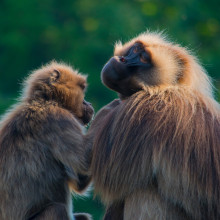
Do primates have their own language?
Chris Smith put this question from Dave on Twitter to primate expert Jacob Dunn from Anglia Ruskin Univeristy.
Jacob - So that's a really big question. And it sort of gets really at the nub of what I'm interested in. Language is a very complicated thing, it's something that we just do very naturally and learn to do with time. The word I guess refers to this sort of complex system of multiple parts of grammar and words that we combine together to form sentences and ideas and so on. Language of course doesn't only come in this sort of spoken form that we're using now it's also written and sign language, Braille and so on as various forms of language. And of course there are languages as well. So the word is a complicated idea.
Do primates have language? Yes because humans are primates and we use language and for many thousands of years other hominin relatives that are relatives of humans would have also been very likely to have been using language. So Neanderthals and Denisovans and the hobbits from Indonesia and so on and even for quite a long time before that it's quite likely that other species like Homo erectus were using fairly complicated language at least quite similar to what we use now.
Chris - I've seen the the brain casts the so-called endo-casts of some of the skulls of some of the aforementioned early human ancestors that you mentioned and specifically they have a bulge in the part of the brain on the left hand side where modern humans have a bulge which is our language center. And paleoanthropologists use this as an argument that probably language was evolving because the brain seems to show the same sort of specialization.
Jacob - Yeah there are lots of sort of quite crude markers of what might represent language in these hominins for which we've only got a few bones. I suspect the brain’s quite a bit more complicated than just whether on the outside of the brain you have a little bulge.
Chris - Dogs have that as well don't they? If you look at a dog's brain it's also slightly asymmetric and we think that's why dogs are quite good at interpreting human language possibly.
Stuart - It is. I would probably argue it's more to do with the tone of it. So when somebody walks in and says “I've spoken to him [the dog] and you knew he did wrong” it was probably the tone of voice used, it wasn't the word used. So I'd probably be a little bit cautious about saying that a lump on the brain means that they know what they're talking about.
Chris - But the dog in the Guinness Book of Records was called Rico? Ringo? and it had a 300 word vocabulary. It was a collie, died now unfortunately. But it had this extraordinary ability you might remember they did the study where you could show it one of its toys which it knew the name for. And you could put a whole bunch of these toys that it knew the name for in the next room and then one new toy that it did not know the name for never seen before and you can say to it go and get the x from next door and the x it knew it didn't know that name so it would retrieve the toy it didn’t know the name for. So it clearly did understand how to engage with and process language.
Stuart - Yeah sure. No I think there's certainly ways in which they can make those associations it's a certain amount of conditioning. But yes.
Chris - Jason?
Jason - I was just wondering if it's a collie that has a 300 word vocabulary, how many of those words are synonyms for food?
Chris - Oh I'd say almost all of them! But back to you Jacob...
Jacob - Yeah, back to primates and the sounds that they make and if that's language, basically it depends on whether people think this is a qualitative or a quantitative difference. There are some aspects of what primates say that we might think of as sort of quite simple language. Several primate species have been known to use “words” in inverted commas that refer to really specific things in their environment. For example the predators or food and they only use those words in those exact contexts you know when they see a leopard or an eagle or something, and they use that word only then.
So they have this sort of equivalent to what we call semantics in language sort of labelling things referring to things in the world. And the other aspect of primate communication which represents something which is similar to something linguistic, is that they also combine words what we call syntax in human language. So they say A and B together and that means something different from a and b independently. And so they’re on a sort of very different end of the scale the question is whether that's a continuum and we’re on the language end and then on the simple end and they use proto language or whether it's something completely different and that's quite subjective.
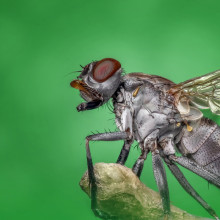
09:59 - Where do flies go in winter?
Where do flies go in winter?
It was over to insect expert Eleanor Drinkwater from the University of York to answer this question from Chris on The Naked Scientists Forum.
Eleanor - Well so this is a really good question. You know there are around 7000 fly species in the UK and unfortunately most the airtime goes to, pardon the pun, go to houseflies or blue bottles you know the kind of big ones that we see buzzing around the place. So for a lot of the species that are much smaller and you don't necessarily notice, they’ll be active all year round but for the big fellas that you might notice, aren’t around this time of year they actually hibernate over winter. Say taking the housefly for example it'll have different generations will be living in breeding over summer, and then towards the winter those that get born just as it's getting cold, will then build up fat reserves and then will go find themselves somewhere cosy so it could be somewhere like, behind a picture in your house or in a nice corner and then they hibernate throughout the winter and then emerge when it gets warmer and then lay their eggs which is why occasionally in the winter you might find the odd fly like flying around your house you’re like “where did this come from?” And it's because maybe you've turned up the heating a little bit and it's suddenly woken up and it thinks it's springtime.
Chris - Usually in my case it's a mouse corpse in the loft.
Eleanor - Oh dear.
Chris - So the bottom line is then these things are there all year round some of them hang out by hibernating, by having laid down body fat, my mind is racing with the idea of an obese housefly. So they store up fat reserves for the winter and then they're ready to go when the spring comes the weather warms up.
Eleanor - If you look at a fly, which you might not have done but, you know, if you like bugs you might. In your spare time, if you look at the fly right at the end of its hibernation you know it might seem a lot more skinny then but then they quickly build up their fat reserves again after winter.
Chris - It's good to hear. Eleanor thanks.
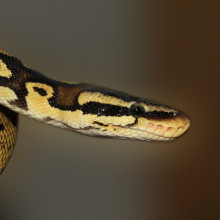
11:54 - How do snakes digest big animals?
How do snakes digest big animals?
Chris Smith asked Jason Head from Cambrudge University to digest this question from Sarah in London. And she wasn't the only one with questions, panelists Stuart Eves and Eleanor Drinkwater had some questions up their sleeve too!
Jason - Well the important thing about snakes and feeding is that other animals will eat prey items larger than they are. So animals will kill other larger animals and eat them. But most animals have the ability to actually break down what they've just killed into small, bite-sized chunks either by tearing at it with their mouths or using their limbs. Snakes of course not having any limbs and having very specialized bodies don't have that luxury. There's only one species that will actually take its prey item, which are crabs, and break them apart in bite-sized chunks and eat the chunks.
Chris - So how does it do it then?
Jason - That snake does that by basically pushing its body against the crab and then grabbing a limb and pulling those pieces off and of course since crabs are jointed and segmented it's fairly easy to do. But for most snakes, the, what they end up having to do is to basically kill a prey item and then get it from outside to inside, which effectively means that the snake is walking over the prey item itself. So it's basically taking its body and moving it over. The specialists for eating big things are boas and pythons. They're the real large prey specialists, and their physiologies are really specialised for building the body up when it's time to eat and then metabolizing the body itself when it's not. So we know from studies of pythons that after they've eaten they actually build up heart muscle, so these animals will build up their hearts, they'll build up the circulatory system, they’ll build up their stomach to digest the animal they've just eaten, some large prey item, and then over the course of having completed digestion thus slowly actually start to metabolize their own body tissues to basically conserve energy and so they have these specialised digestive enzymes where they can completely digest whatever prey item - with mammals it's usually only things that are made of keratin that survive.
Chris -That's the hair isn't it.
Jason - Yeah yeah so hair and nails and everything else is digested by the snake, they’re incredibly efficient.
Chris - Even bone?
Jason - Oh yeah absolutely.
Chris - Good grief! Stuart?
Stuart - So having been at a child's party earlier on and tried to tackle a large piece of cake..
Chris - Hold on! We’re just talking about snakes eating large things
Stuart- I am getting there I'm getting and the question be - how do they breathe? Because, if they're going to walk over, say a ra, presumably that is going to be a relatively large kind of piece of prey. There must be a point where they struggle to breathe. You can see how the party went for me this morning.
Chris - Were you getting tempted to feed a 4 year old to an anaconda?
Stuart - No I tried to eat something that was way larger than I should have.
Jason - It's an interesting question. Well I should say, I don't know if there have been studies that have actually looked at respiration while they feed, certainly bacon go periods of time without breathing. So they can move the prey item down. The trachea and the lungs the snakes are really very very specialized into themselves and I think would be very hard to actually pinch that off.
Chris - Can snakes throw up because if they if they take something in and then they think second thoughts this is bit less digestible than I had in mind.Can they get rid of it.
Jason - They can and they'll do that when they're threatened actually. So, there's lots of videos you can see online of people kind of finding a snake and harassing the snake until it vomits up its prey. It's incredibly damaging to the snake, to do that, so don't ever do that if you see a snake that's just fed.
Chris - I've never seen snake feces, do snakes poo?
Jason - They do. I've kept pythons before it's not enjoyable, but it is just bits of resistant tissues again like hair and nails and then big piles of uric acid.
Chris - Right. So what is it like, a Mr Whippy, 99 Flake sort of action or is it just little bits of debris, because they can't be much left at the end of this?
Jason - It's much more like bird poo than you might think.
Chris - That figures given the evolutionary relationship
Jason - Again you know with some of the more resistant bits in a shall we say more identifiable bolus.
Chris - You were going to ask something Elena?
Elena - Oh this is a really disgusting question, but I've been curious. Once in the jungle we came across a snake and we tried move it off the path, but the person who picked it up, it was still alive. They fell apart and then inside it was this like rotting decaying mouse. And we thought it might be because it got cold and wasn't able to digest it, or would it be that the snake was sick?
Chris Are you saying the snake fell to pieces?
Elena - Yes, iIt was the most horrifying thing I've ever seen before.
Jason - You ran into a very unhealthy snake it sounds like.
Elena - It’s too cold?
Jason - I assume it would I don't know enough about kind of tropical snakes, but I think one of the interesting things about some of the very potent toxic venoms that snakes have. One of the theories behind viper venoms, the rattlesnakes and vipers with those big hypodermic needle like teeth is that that's actually an adaptation for injecting the prey with digestive enzymes in a cool environment where you actually wouldn't be really effective at breaking down the prey item. So what you do is you instead you just give it a shot of digestive juice to begin with.
Chris - A question we get asked quite a bit is is a snake resistant to its own venom. So if a code repeats itself or bit a cobra identical to it would it be vulnerable to its own venom.
Jason - To my understanding yes.

Why can't dogs eat chocolate?
Chris Smith asked vet Stuart Eves from Cambrudge University to break down this question from Caoibhe on Twitter. Then panellists Jacob Dunn and Eleanor Drinkwater had a question of their own.
Stuart - Well it's quite timely given that Easter is coming and, certainly for vets, that's the big time when these things tend to happen. The fact is that chocolate contains an active ingredient, theobromine, which is relatively toxic and it has a certain kind of toxic element to us but we metabolise it. We break it down into various compounds rapidly. And while we have some activity it’s much less so. On the other hand, unfortunately, dogs have this enzyme pathway, this way of breaking it down which creates a lot of very active components.
And what that usually means is - I think the numbers go something along these lines - if we would break it down, it should be half gone after in about six hours, whereas for dogs, it is something like eighteen. It just stays too high too long for them. Now the one thing to say is it does depend on the chocolate and, every vet out there will know, we will have these anecdotes of a Jack Russell which ate a large bar of chocolate and seemed fine and then we have one of a great dane which ate a small amount of chocolate and there was a problem. So the dose varies massively and the quality of the chocolate really matters.
Chris - What does it do to the dog? How would you know if your dog had got chocolate poisoned? Obviously, you'll see the wrapper left on the floor.... But how might you spot this?
Stuart - Absolutely. It's a stimulant so it's actually very similar to caffeine in coffee or something called theophylline which is in tea. So heart rate goes up, blood pressure changes all over the place. The usual response, and we've already been on vomiting so I feel okay to now broach this, the usual response of dogs is to vomit and actually hopefully that's the best thing if they have brought it up. But they're the kind of signs you see.
Chris - Jacob?
Jacob - I was just gonna ask whether dogs are lactose tolerant because quite a lot of cats are lactose intolerant, aren't they? Presumably it's milk chocolate, that might be another cause of tummy is getting a bit funny.
Stuart - Yes, tummy is going funny? Yes, in theory, absolutely. That's kind of okay. I'm more worried about you get these nice chocolates now that contain raisins. Now there's a problem with raisins and dogs and coffee beans.
Chris - Really?
Stuart - Yeah, that was the tannins in raisins are another risk factor. Raisins themselves are quite toxic.
Chris - I had a dog that loved grapes and, of course, a raisin is just a dried grape.
Stuart - Yes, so they’re concentrate if you dry them so it's the difference between grapes and wine I guess so it's just the combination that you have.
Eleanor - What about other types of pets, what about cats? Can cats eat chocolate or is it the same story?
Stuart - It would be the same story but they don't. And the underlying reason is actually that cats have a defect in one of their two taste receptors. When they actually taste sugar and when we taste sugar it's made up of two halves of a receptor. Cats actually have a defect in one of them which means they don't taste sweet stuff so they won't eat it. I hope I'm right on that one but that's certainly what was said.
Chris - So you’re saying, if you gave them a choice between something sweet and something not sweet they would not be able to discriminate?
Stuart - No, because they can't taste sweet. They live on protein bars of mice then it doesn't matter. You don't need to, so no.

21:23 - Petting Zoo: Show and Tell
Petting Zoo: Show and Tell
with Stuart Eves - Cambridge University, Jacob Dunn - Anglia Ruskin University, Jason Head - Cambridge Univeristy, Eleanor Drinkwater - York University,
Our panel brought in some interesting items into the studio. Joining Chris Smith is Vet Stuart Eves from cambridge university, Jacob Dunn from Anglia Ruskin to talk about primates, Reptile expert Jason Head from the Zoology Department at Cambridge University and Eleanor Drinkwater from York University for everyone's insect enquiries.
Stuart - Okay. Well I have to say at this point that your producer took me down from the original plan which was to bring in what is called a Sulcata tortoise which is about two stone of very angry shell. So what I'm going to do is: I'm just going to dive down into the box now and we have two red-foot tortoises which are kind of pets of ours from home. We have a whole range of tortoises and I thought it'd be a fun thing.
Chris - Because that’s a shell of a show and tell! Oh my goodness, that's enormous.
Stuart - Yeah what I've got in my hand is, she's probably about 25-30 centimetres long. This is this is Tina who's one of our red-foots. So she's quite a dark colored tortoise but then, actually, the really striking thing about her is on her front legs she has these really bright cherry-red scales, really.
Chris - How do they grow?
Stuart - In terms of with the shell?
Chris - Yeah.
Stuart - So very much like trees or very much like nails, if you like, they effectively add an extra kind of layer where the two plates come into contact with one another.
Chris - So the bumpy bits on the outside...
Stuart - Yeah
Chris - That's - each of those is a plate?
Stuart - Effectively it's a plate, there would just be multiple ones of them.
Chris - So it’s made of keratin is it? The same stuff as my fingernail?
Stuart - It's very similar to bone, and certainly the ones along the top will actually be fused with her backbone, her vertebrae. So the shell and and their actual kind of skeleton is one thing, but yes.
Chris - They're depositing a new layer almost like nail growth all the way around each of those sort of square plates? And so the whole shell grows...
Stuart - … like tree rings. Yeah, just adding and adding, I guess just because there is a junction.
Chris - Jacob?
Jacob - I just had a question because at moment my daughter Lily is looking for her next pet, she’s a budding animal rescuer. How cat-proof are tortoises?
Stuart - Ahm… there's also the question of how tortoise-proof is the cat... It's difficult, it would depend on the individuals. These things, they do have very good defences. They'll put their head in, they'll bring their front feet up to protect themselves. They are very good pets, all I would always say is: do a bit of research on how they live, because these are highly specialised animals.
Eleanor - Talking of being a good pet, is it actually pooing right now?
Stuart - Errr, there’s a possibility. Yeah.
Chris - Moving swiftly on. Rather like the tortoise. Or not! What about their hibernation, though? Because these animals do hibernate don't they? Because they would normally have a long sleep - because my mum used to have a couple of tortoises when I was very little and we used to put them in a box in the shed for the wintertime and they would go to sleep. So what is their normal life cycle?
Stuart - Sure. One thing to say, some tortoises will hibernate and others don't. So Tina who I've got in my hand and then Solomon who's her boyfriend who's still in the box. They are not the type of tortoise that would hibernate and it goes back to really where they're from. If they're from the tropics there would be no real change in season, there's no real kind of need. They might actually do the opposite and they might aestivate and actually kind of see their way through the summer and warmer times by hiding. How it's done? Well some people put them in the fridge
Chris - And it initiates the process?
Stuart - Yeah, well, the slow drop in temperature - you need to take them down to 5 to 8 degrees. I do need to qualify that by saying just just any fridge. They do need ventilation and other things, but yes, it's not uncommon. I've known friends where you go round their house, you open up the fridge in the garage and what is in there? It is a whole load of tortoises!
Chris - And they’re not for dinner? We should emphasise they’re not for cooking!
Stuart - I have been assured they're not.
Chris - Goodness me. Stuart, thank you very much for bringing in Tina and Solomon, it's very nice to meet them. Hopefully they're not going to destroy the studio any more while they're with us now. Now Jacob, at the other end of the spectrum you've put down a pot of rather sinister looking something, next to my chocolate biscuit which is making me quite alarmed. What's in that pot?
Jacob - Well I brought sort of two related things for show and tell here. One is from one end and one is from the other end. So I'll start with the top end. This is a Howler monkey skull. These are what I study, which are primates from Latin America, all the way from Mexico down to Argentina. And they make these incredible noises and the reason they can make these incredible noises is because they've got this big, big bone which all vertebrates have but in Howler monkeys it's sort of expanded into this huge sort of cup-shaped chamber and it's just this most incredible feature of the Howler monkey.
Chris - Because in us that is a little strip, it is thinner than a finger, the sort of crush in the middle of your neck. If you were going to, sort of, cut someone's throat, that's roughly where the hyoid bone is, isn't it?
Jacob - Exactly.
Chris - It's just there to stabilise the muscles in the neck. But that's huge and it’s an enormous thing!
Jacob - In all primates it's in the same place, but Howler monkeys have developed this trick to expand it and they've got this really adapted hyoid bone that's sort of this big sort of balloon.
Chris - And that's how they make the sound they make?
Jacob - They do this inhale and exhale. And they go [fierce Howler monkey impression]
Chris - That's very good! You can see that you spent some time with them…
All - [laughter]
Jacob - I have spent a lot of time with Howler monkeys!
Chris - Because they’ve learned how to copy you!
Jacob - And when spending time with the Howler monkeys, most of the time that I've spent in the jungle, which was about five years in total I guess, I was collecting stuff from the other end. So what I've got in this other tube here is some Howler monkey poo.
Chris - Yeah.
Jacob - And there's a good reason why poo is a really wonderful resource for biologists. You can sequence DNA from poo, you can work out what they've been eating, both from the sort of seeds and things you find in there as well as sequencing the DNA of any bugs or fruit or anything. You can also look at what bacteria are in there. So you can actually learn an incredible amount from collecting poo without having to be invasive. You don't have to capture the animal or anything.
Chris - So there’s no stress for the animals, you just go and you can follow because you can identify the DNA of the individual that made the poo, in the poo. You can track individuals and see how their life is changing and how seasons and other factors are affecting them.
Jacob - Absolutely.
Chris - Cool.Thank you, Jacob very much. Now, Jason, you are holding your mobile phone, are you going to do something with that?
Jason - Yeah. So, because I work with fossils I don't have the capacity to bring them in but because we're talking about kind of large bodied reptiles and things like that on this trip, what I have actually, is a clip on my phone. It's a video clip that I took two summers ago when I had the opportunity to go to Rinca Island in Komodo National Park in Indonesia. And so I'm just going to pass this over and you can hit play and let us know what you’re seeing.
Chris - So he’s giving the phone to Eleanor.
Eleanor - Oh! There's an adorable komodo dragon, which is kind of wandering over.
Chris - So when you say adorable, how big, relative to Jason?
Eleanor - Erm… I don't know. Maybe… How big would you say that was?
Jason - That one was two meters long.
Eleanor - Oh, it's really cute!
Chris - And is it after him?
Eleanor - Well it’s kind of walking towards him and it’s kind of going a little bit faster. He just wants to say hello!
Jason - We were in the forest on Rinca Island and the dragons are very habitat-specific in the national park area. So the dragons are born in these little valleys and they’ll actually live their whole lives in the valleys, but when you have a lot of tourism moving through, and tourism is starting to become a problem for the National Park, the dragons will move around a little more. And this one was just kind of coming up very quietly to, I'm sure, say hello and not bite my achilles tendon or anything like that… But fortunately I was with some dragon biologists who were quite adept at using large sticks to...
Chris - Just fend it off?
Jason - ...prod the dragon off, yes.
Jacob - Don’t they have some really nasty stuff in their saliva that would do you damage if they were to bite you?
Jason - Yeah. There's been a whole history of study and conjecture about Komodo dragon saliva, that for many years it was thought that they had this kind of toxic bite, a septic bite, because it was thought that they would collect rotting meat in the serrations in their teeth and that would generate all these toxic bacteria. Because we know that dragons will bite water buffalo and the water buffalo will die of sepsis or die of an infection in the wound usually weeks later and the dragons will kind of follow them around for weeks until they keel over and they'll eat them. More recent studies have shown that there actually are some specialised enzymes in their saliva that basically lower blood pressure and are also anticoagulants, so they keep the wound open. They're not toxic venoms in the way that a cobra rattlesnake would have them, but they do definitely facilitate keeping the wound open. And probably what is happening is that animals at the dragons bite are mostly standing in puddles of bird faeces, so that's how they get the sepsis. So I think that these are strategies for the dragons to be able to eat the food items.
Chris - They're amazing creatures aren't they? Because they can also start a new colony of dragons from just one female dragon, because genetically, they can undergo parthenogenesis and the next generation in an egg, if it's not fertilized, actually ends up being male by default. So if you've got just a female washed up on a remote shore or something, the egg she lays will by definition turn into a male. So you can then start a new sort of sexual reproductive cycle with them. They're amazing creatures.
Jason - Yeah. And I think that was discovered at the Chester Zoo when they had one female who had never mated and gave birth to viable eggs.
Chris - Yeah, in 2005-2006 they actually published that as a paper in Nature. I remember reading about it. Eleanor, you’ve got a packet in there. It's not as thrilling as a pot of poo. But what's in your little packet?
Eleanor - I say it's just as thrilling as a pot of poo, if not even better, because it's to do with invertebrates. So this is actually a tag which we had custom made to track Titan beetles in the French garden rainforest.
Chris - Can I have a look?
Eleanor - Yeah sure.
Chris - To describe this for people there is a little ball. It's about the size of my little fingernail and sticking out of it is this long thin hair-like projection. It's about the size of a hair, actually, but it's a little aerial, like a little antenna. Is that a tag?
Eleanor - Yep, that’s a tag.
Chris - For what?
Eleanor - So that's for a Titan beetle. So, Titan beetles…
Chris - You glue that on a beetle?
Eleanor - Yeah well, we were trying to understand the movement of this particular beetle, It's the biggest beetle in the world and no one knows anything about its behaviour.
Chris - How big is big?
Eleanor - So biggest it gets to its 16.7 centimetres. So the biggest one we found was 15 centimetres. And, you know, you can pretty much have a wrestling match with this creature.
Chris - That’s big!
Eleanor - Yeah! And occasionally that a break out of their tanks and trash our kitchen. They are very, very destructive little creatures. So yeah.
Chris - What have you learnt?
Eleanor - The reason why we're interested in them is that they’re highly trafficked as a species, they're very very valuable. We get collectors who pay a lot of money to have dead specimens of this animal. And unfortunately a lot of our specimens are actually recaptured by local hunters in the area.
Chris - So you don't get any data?
Eleanor - We did get some data, but it was very unfortunate whenever we would track our data and then we'd track it to a person and then he'd be like: “Oh is this yours?” and you’d be, like: “Yes, this is mine.”
Chris - So in that gadget is there a little power supply that then beams a signal out that you can track?
Eleanor - Yes.
Chris - How long does it last for?
Eleanor - They last about two or three weeks and they've pretty good range on them, particularly, you know, considering that we're working a very, very dense dense rainforest.
Chris - And how far do these beetles move, though? Because they're big - you're saying 15 centimetres across. What's their range?
Eleanor - Yeah. So they're really interesting. Most of the time they don't do anything. They kind of sit around and we track them over a while, and we just found that they moved less than a metre. And then, on Sundays - we didn't manage to track this, but according to anecdotal reports from local entomologists - they climb up trees and then they use the height of the tree, essentially, to kind of parachute down, and apparently they reckon that they can go kilometres like this which is just... I’d love to see it!.
Chris - How much do they weigh?
Eleanor - They weigh a lot, maybe 30 grams the biggest one.
Chris - Okay. But even so... I'm just thinking, it's like a cricket ball coming at you, or a football actually, isn't it? Coming at you from the sky.
Eleanor - You have to be careful as well. You know, they’ve got these incredible mandibles that can actually bite to the bone. So if it gets your finger, it's a quick trip to the hospital.
Chris - Amazing stuff you get up to, Eleanor. Thank you very much

33:32 - Zoo&A: Getting Quizzical!
Zoo&A: Getting Quizzical!
with Stuart Eves - Cambridge University, Jacob Dunn - Anglia Ruskin University, Jason Head - Cambridge Univeristy, Eleanor Drinkwater - York University,
It's time for a quiz! Chris Smith paired our panel into teams. Team One was primate expert Jacob Dunn and insect enthusiast Eleanor Drinkwater and Team Two was supervet Stuart Eves and reptile expert Jason Head.
Chris - So first of all, this is ‘weird science’, round one. Which of these animals, Jacob and Eleanor, has the highest blood pressure? Elephant; blue whale; giraffe; or flea? What do you think?
Eleanor - Must be giraffe… They've got really long leg necks!
Jacob - Fleas don’t have blood.
Chris - You’re gonna go giraffe?
Eleanor - Yeah, giraffe.
[sound for correct answer]
Chris - Yeah that's absolutely right! Owing to their long necks, giraffes do require a significant blood pressure: 280 over 180 millimeters of mercury. That's more than double the human equivalent - in a human it's about 180 over 80. Elephants a close contender: 180 over 20 for an elephant. But whales have very low blood pressure despite having blood vessels you could drive a car through in some cases. They've got such big blood vessels that the blood pressure is actually quite low and they're in a marine environment which also makes a difference. So well done, plus one to you.
Chris - Right. Jason and Stuart, here is your question. What's the biggest fruit that a blue whale could swallow? Is it (a) a watermelon; (b) a grapefruit; (c) a kiwi; or (d) a grape? What do you think?
Stuart- I’m gonna work on the fact that, because I think they probably an awful lot of krill, they don't actually probably need a massive esophagus to get it down. So I'm erring towards the smaller end. I'd probably pitch kiwi.
Jason - I'm going to go with the caveat that everything I work on is dead when it comes to thinking about this answer. They do have large throats... I would be tempted... I've lost this quiz every time I’ve played it, which makes me think that my answer is probably wrong. Either way I would think they would have a larger esophagus it would probably…
Chris - I’m gonna have to hurry you.
Jason - Grapefruit.
Chris - You're going grapefruit?
Stuart - I'll go I'll go with.
Chris - So the vet is deferring to the guy who works on dead stuff.
Stuart - Yeah.
[sound for correct answer]
Chris - But it is the right decision because it is a grapefruit. The blue whale’s esophagus for the right reason it's only 4 inches in diameter. They feed on plankton, exactly as you say, Stuart. They also eat small fish and marine crustaceans so they don't really to swallow very much. A grapefruit-sized object would fit down. Right, round two back to Jacob and Eleanor. It's one each on the scores at the moment, so you’re level pegging.
Chris - Is this true or false? Your dog could catch your cold. What do you think?
Eleanor - No. No. It can't be. No, I don't think so, it doesn’t sound right.
Jacob - False.
Eleanor - False.
Chris - You can’t give a cold to a dog?
Eleanor - I hope not.
[sound for correct answer]
Chris - You’re absolutely right! It is indeed false. The viruses that cause human common colds, like rhinoviruses are quite different from their canine equivalent, so your dog isn’t going to catch your cold if you sneeze in it. But there is an exception. Influenza viruses can jump between owners and their pets - that includes dogs. There's also one study in the literature: in 2009, a pet cat is documented to have died of swine flu. The owner got a catastrophic dose of swine flu and transmitted the infection to the cat. Plus one to you.
Chris - Back to Jason and Stewart. flies can taste food through their feet. What do you reckon? True or false? Did we make that up or is that true?
Stuart - Something in the back of my head says I've heard this before, and the answer is yes.
Jason - I will go with that as well.
[sound for correct answer]
Chris - You’re on fire! Everyone is doing very well. You might be changing history for yourself, Jason.
[laughter]
Chris - Indeed, the legs and the feet of flies, including butterflies have structures they call chemosensillium. They’re the insect equivalent of taste buds so they taste their food by walking on it. And that's pretty important because, before they stick their proboscis (the long straw-like thing they're going to suck the food up through to eat); they don’t want to suck up something they don't like, but they've got to get it into them before they discover they don't want it. So that's why they walk on it first: to see what it tastes like and see if it tastes juicy. So we are level pegging. Two all. So it's all on this round. Decide whether it goes to a tie breaker.
Chris - This round is called ‘weighty matters’. Which weighs more, Jacob and Eleanor: 1 ostrich egg or 30 chicken’s eggs?
Eleanor - Oh…
Jacob - One ostrich egg is really big.
Eleanor - But 30 quite a lot.
Jacob - It may depend on the size of the chicken egg.
Eleanor - Yeah, it’s a good point!
Jacob - When you go to a supermarket you get small, medium, large…
Chris - I’m going to have to hurry you!
Eleanor - Ostrich! Let’s go with ostrich.
[sound for wrong answer]
Eleanor - Oh no!
Chris - I'm sorry. It's actually the chicken eggs. Because the ostrich egg is the largest egg, it weighs 1.6 kilos and it's the equivalent of 25 big hen’s eggs. It takes 35 minutes to soft boil one.
Eleanor - [laughter]
Chris - My recipe du jour. Jason and Stuart, let's see if you can clinch it with this one and change, or, undo the PTSD that Jason's clearly suffering from as a consequence of previous experiences on the program. All of the humans on Earth, or all of the ants on Earth? What weighs more?
Jason - We will go with ants.
[sound for wrong answer]
Jason - Oh no!
Chris - I’m really sorry. No, it's actually the humans. There are more than 7 billion people, the combined weight of 7 billion people is more than 330 billion kilos. Now the estimates vary for the numbers of ants but if we take an upper limit of more than ten thousand trillion ants on Earth, which seems reasonable, the combined weight of all the ants will, therefore, be 40 billion kilos because an ant weighs about 4 milligrams. So we do outweigh the ants by about 10 to 1.
Chris - So it's a level pegging role to a tiebreaker. Right. Okay. You can still win, Jason. It's okay. You can do this! Okay. This part of the show what you've got to do is you've got a guess, ok? And the person who gets the closest answer gets the point. So it's all on this one. There is enough human DNA in an average person to go from the sun to Pluto and back how many times, do you think? You may confer in your teams, I’ll ask you what you think the answer is, and then we will work out who's closest. So we'll start with Jason and Stuart, what do you guys think? What's your answer?
Stuart - I think we'll go twice.
Chris - Twice? And what was your answer on this [asking Eleanor and Jacob]?
Eleanor - We decide to go for 8 times.
Chris - Well I'm sorry to say, Jason, you have not won. The answer 17 times. It's 6 billion kilometres to Pluto, there are 2 metres of DNA in every single one of your between 37 and 100 trillion cells in a person. Which means, actually, you’ve got enough in there to go 17 times to Pluto and back if you strung your DNA end to end.
Chris - And the winners this week (please give a quick round of applause) are: Jacob and Eleanor!
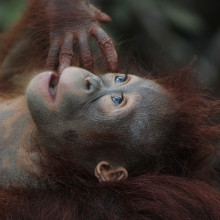
39:59 - Monkeys versus apes
Monkeys versus apes
We received this question on The Naked Scientists forum. Chris Smith asked zoologist Jacob Dunn from Anglia Ruskin University to explain the difference...
Jacob - In basic terms in simple terms, primates are distinguished into two major groups so there's the group that has the lemurs and lorises and bush babies. And then there's the other big group of which we are part, which are all the monkeys and apes and these other funny ones called the tarsiers, but we won't worry about them. And so simply put within this group of the monkeys and the apes, monkeys are everything you find in the Americas and all the monkeys that you find in Asia and Africa and the apes are just the apes - gibbons, gorillas, orangutans, bonobos, chimpanzees and humans.
Primates are all of these things so all of the lemurs and lorises and all of the monkeys and apes are all primates. And this is where the sort of slightly more complicated answer comes in because really the bigger layer is primates. And then within the group of the monkeys and the apes the next sort of layer within this nested hierarchy if you like is what we would call monkeys. And within that we find the apes so in sort of technical terms, in terms of organizing species, actually apes are monkeys. And so that's where it starts to get a bit more complicated and circular. So the words monkeys and apes are actually in scientific terms they're not very useful words but in simple terms it’s the difference that I said with the simple answer.
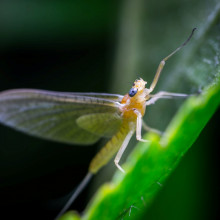
41:34 - Why do some insects only live for a day?
Why do some insects only live for a day?
We received this question from Stu on Facebook. It was over to Eleanor Drinkwater from the University of York for an answer and zoologist Jacob Dunn and vet Stuart Eves was able to relate nature's ability to adapt!
Eleanor - Basically it’s because they are brilliant. And they are just amazingly adapted to be able to carry out the entirety of reproduction that most mammals and other animals take ages to do, they’re so well adapted that they can do it just within 24 hours or a couple of days. So if you think about the different adaptations that this species come up with, so you have a mass emergence. So they all emerge at the same time so they can easily find a mate. The emergence sites are where they can also lay their eggs. They don't need to find a site to lay their eggs and also their bodies are completely adapted to finding a mate. So while they are looking for a mate they don't actually have working mouth parts. They can't actually feed. So they are just entirely focused on finding a mate. So the answer is, it really is, because they can do everything that they need to within that really short time frame.
Stuart - Sorry I have to just say that one of the most heartbreaking things I've ever seen watching a nature documentary, is they went through the entire life stage of the mayfly. And there was the point where it just rose out of the water in its flying stage, I presume. And then the trout came up and got him. And of all the documentaries I've seen you think oh that's such a shame because, what's the kind of ratio between how long they're in their kind of larval stage and then when they actually fly for the day.
Eleanor - Well I'm not sure but you get a lot of invertebrates which have a really long larval stage and then they only emerge for a few days. So for example the beetle which I mentioned before, the Titan Beetle which I've studied. It can live, they estimate it lives as a larvae for like five possibly 10 years and then it emerges for two weeks and then dies which I just think is amazing. But I think it's the journey, not just the destination. You know? It might be great being a larvae.
Chris - Aren’t on some cicadas, like that? Don't they have a sort of prime number ratios where they come out every 13 years or so some of them. and they've been underground for that long and then they come out do their thing, mate, and then that's it for them.
Eleanor - I don't know about cicadas precisely but there are some amazing adaptations to be able to to work out when everybody else is emerging at the same time it's just crazy.
Chris - It's like coral spawning I suppose. Jacob?
Jacob - I was going to say, I think there are some vertebrates that have similar strategies as well maybe you guys can help me out a little bit. I'm struggling to think of examples. But I think maybe octopus as well, and whether they're called Semelparous species that basically have a one off reproduction in their lifetime and they go all out and they have millions and millions of gametes and they just go crazy and then they die pretty much immediately afterwards. Whether you guys can help me out with any more examples.
Stuart - You know certainly my line of work, yeah we breed more often I guess in the mammalian side of things.
Chris - Cheers Stuart.
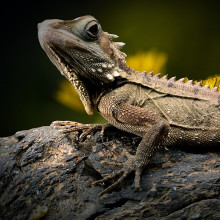
44:23 - Why aren't reptiles as big as dinosaurs?
Why aren't reptiles as big as dinosaurs?
This sizeable question came from Jake on twitter. Jason Head from Cambride Univeristy joined Chris Smith in the studio to rattle on about reptiles...
Jason - The reason that we don't have terrestrial reptiles the size of Mesozoic dinosaurs today, is that that particular history stopped in a series of extinction events throughout the Mesozoic. Living dinosaurs of course are birds, and there have been some really big birds throughout their history but birds are specialised for being comparatively lightweight. Their bird bodies are adapted for flying for the most part. Other groups of large reptiles, things like snakes, crocodiles, turtles, lizards all have these different histories of large body size evolution through time and actually one of my graduate students is working on this very question right now about whether they're big trends. But really what's happened in the Cenozoic, since since the end of the Cretaceous, the last 66 million years is that the large body size new is pretty much occupied by mammals right now. So we don't really see opportunities for any of the living reptile groups to adapt to any of those environments. And it really has to do with eating plants and how mammals, modern mammals, are specialised to eat plants in a way that living reptiles aren't.
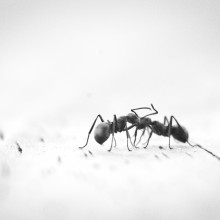
Do ants get lost?
Chris Smith put this question from David on The Naked Scientists forum to insect expert Eleanor Drinkwater.
Eleanor - Oh, probably not. Sadly, ants tend to be very territorial so chances are he'd probably wandered into someone else's territory and unfortunate things might happen to him. But I'm gonna caveat this by saying that different ant species have incredible navigational abilities. If it's still within the foraging range of this particular colony, which sounds unlikely given the scale, they might just find they're way back. Different ants navigate in different ways so like, for example, some desert ants, they count the number of steps away from that their nest. And whereas other ones would rely on visual cues. There was a study done on sugar ants in which they picked it up and they plonked it somewhere which was still within the foraging range but away from home. And they found that they could find the way back. But if it was outside the foraging range, the poor little fellows would walk round around in circles trying to find visual cues which unfortunately they wouldn't because they're out of their range.
Chris - So it's curtains for the ant off the third floor balcony point?
Eleanor - Yeah probably.
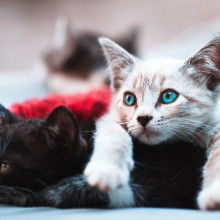
46:44 - Why do cats play with their food?
Why do cats play with their food?
We received this question from Annie. It was over to supervet Stuart Eves from Cambridge University to dish up an answer
Stuart - Sure. I mean it's an excellent question and there's really two trains of thought, one of which I don't really buy in to, which is that it's there to tire them out. The idea being that if you tire them then the mouse is unlikely to bite the cat's paw or something.
One of the ideas I do really buy into is the idea that you're testing the fitness of your prey. So if we think about mice, they could have eaten poison and what they're doing is they're making sure that the mouse is behaving normally. Such that it can fight back that it's behaving normally. One of the big threats to cats certainly is a parasite called Toxoplasma which can alter the mouse's behaviour actually. It makes them much more bold. And so if the cat gets a feeling that this mouse isn't behaving normally, it may kill it but it might not eat it. It's along those lines and that rings true for me. That seems reasonable.
Chris - Jason?
Jason - Is toxoplasma bad for cats?
Stuart - It's not particularly bad for the cat, it can cause them to lose litters of kittens, it's incredibly bad for people, it's incredibly bad for almost every mammal. But the cat is the definitive host. This is where the toxoplasma wants to be and where it breeds. And as such actually it tries not to hurt the cat.
Chris - So if a human catches toxoplasma then it gets into all out issues, including our brain. And some people suggested it may even change human behavior. So are you saying then that when toxoplasma goes into a cat it doesn't go through the cat's body and into all its tissues and its brain like that?
Stuart - Well it would certainly circulate around but it's the idea that it's got to get to a position where it can pass to other generations of cats and, of course, eventually get back into a host.
Chris - So it doesn’t want to kill the cat?
Stuart - It doesn't wanna kill the cat. It's got no advantage in killing the cat actually but it finds itself accidentally in other mammals.
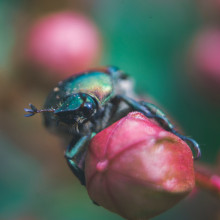
48:44 - Why are insects bigger in tropical areas?
Why are insects bigger in tropical areas?
We received this question from James in Amsterdam for our insect expert, Eleanor Drinkwater from York University. It was then over to vet Stuart Eves who is all too familiar with animals, great and small.
Eleanor - Well, this is one of the things I love most about the tropics is the incredible sizes of just spiders that would blow your mind, and beautiful beetles. It is really down to two really simple things: for something which is an invertebrate to get big it tend to need two things, one of which is warmth helps, it's better if it's a bit warmer, and then also having constant access to food. So somewhere like the UK you know you have this problem about winter.
And so you know everything kind of stops over winter, whereas in the tropics you kind of have this amazing opportunity for things to be able to develop all the year round, which is why you end up getting the opportunity for some of these amazing species. The really interesting thing though, is that - so that’s on the species level, on the individual level, microclimate is really really important. So for example their conditions which a particular beetle might have to grow up on one side of a garden might be completely different to a beetle that lives on the other side of the garden because one side has shade and one side has sunlight which means that on the individual level it's the microclimate that's the really important thing. So big species grow in the tropics but just because it's in the tropics it doesn't necessarily mean that it'll reach its full potential.
Chris - But humans... Because we don't feed someone properly they don't grow very much. Stuart?
Stuart - Yeah, only really that it does compare with what's happened in development of domestic dogs, where as we've domesticated them one of the things we think's happened is that because they wouldn't have maybe got as much food as they could have done in the wild, it's led to them becoming smaller. And of course from our point of view, that was great because no one wants a wolf when you could have a slightly smaller cuter looking wolf. So actually this kind of not necessarily getting the nutrition that you would normally need has actually, I say benefited us, but it's part of the domestication process. So it kind of rings true with that.
Chris - So what happened to a pug then?
Stuart - We happened to pugs I'm afraid..
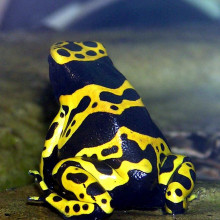
51:03 - What does it mean to be cold blooded?
What does it mean to be cold blooded?
Listener Jon emailed into the show. Chris Smith put his question to Jason Head from Cambridge Univeristy.
Jason - Along with ‘living fossil’, ‘cold-blooded’ is my least favorite word combination. It is talking about metabolism and whether or not an organism maintains a very high, elevated, or constant metabolic rate; or a lower metabolic rate that is basically dependent on the ambient environment that it lives in - so how much food it eats and how much oxygen it requires. And so there's this classic idea that cold-blooded animals get sluggish when the environment gets colder because the external environment controls their temperature. In the case of amphibians, many amphibian groups - especially things like croakers and peepers - they have all sorts of secondary adaptations to keep themselves warm or to keep their blood from freezing.
They can have high concentrations of glucose in their bloodstream and in their tissues, and that acts as a natural antifreeze. And many groups of what we would call ectothermic or or poikilothermic animals (so these are the classic cold-blooded groups) have actually come up with secondary adaptations to function very efficiently in cooler environments. When we think of cold-blooded animals like lizards and snakes - especially lizards and snakes and their relatives - those animals are really specialized to conserve energy, so their type of cold-bloodedness is an adaptation for minimizing the amount of energy you have to expend in your life. So that allows a high degree of diversity in the tropics and certainly less numbers of species as you go up into the higher latitudes but you still find cold blooded animals toward both poles and they have all these really excellent specializations for surviving just fine.
Chris - So basically, although their body temperature is lower, their tissues are optimised so that despite the lower temperature they can still make their tissues, their muscles, and so on, work just as fast as they need to at those sorts of temperatures. They've just evolved to operate to those low temperatures?
Jason - Yeah. And they've also, some of them have evolved specializations to elevate their body temperatures beyond that of the ambient environment so that they can, instead of being specialized to have the tissues work at low temperatures, they can simply keep the tissues warmer than otherwise you would have based on the temperature around you
Related Content
- Previous Ancient javelins
- Next Brain centre for laughter










Comments
Add a comment